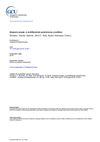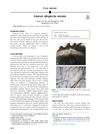Management of Alopecia Areata
June 2002
in “
Clinical and Experimental Dermatology
”
TLDR Alopecia areata management involves explaining the condition, using treatments like steroids and immunotherapy, and providing support like counseling and wigs.
Alopecia areata was a chronic inflammatory disease likely mediated by lymphocytes, with a polygenic predisposition and environmental triggers. Management focused on explaining the disease and treatment options, as spontaneous remission was common but recurrence was likely. Poor prognosis was associated with childhood onset, lack of recovery within 1 year, and extensive hair loss. Treatments included topical steroids, minoxidil, and dithranol, though their efficacy was comparable to placebo. Intra-lesional steroids were effective for limited hair loss, while pulsed high-dose systemic steroids showed promise in uncontrolled studies. Contact immunotherapy was the most effective for severe cases, but had a low long-term response rate and safety concerns. Counseling and wigs were important for patient support, and patients were advised against ineffective and costly treatments.


